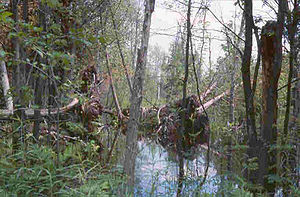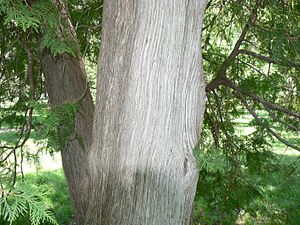- Coniferous swamp
-
 Dead Stream Swamp, Michigan. A northern white cedar swamp.
Dead Stream Swamp, Michigan. A northern white cedar swamp.
Coniferous swamps are forested wetlands in which the dominant trees are lowland conifers such as northern white cedar (thuja occidentalis). The soil in these swamp areas are typically saturated for most of the growing season and are occasionally inundated by seasonal storms or winter snow melt.
The substrate is usually organic in nature and may contain peat in varying amounts or be composed entirely of muck. The swamp substrate is typically nutrient rich and neutral to alkaline but can be acidic and nutrient poor.
Coniferous swamps vary in composition, with different species of conifer dominating, and varying amounts of deciduous hardwoods growing within the swamp. A wide diversity of plants are represented within the swamp with certain species dominating in a variety of microhabitats dependent on factors such as available sunlight as in cases of trees downed by wind or disease, soil Ph, standing groundwater and differences of elevation within the swamp such as tussocks and nurse logs.[1][2]
The different types of coniferous swamps are referred to according to their dominant trees rich conifer swamp dominated by Northern white-cedar which typically occur south of the climatic tension zone throughout the Midwest and northeastern United States and adjacent areas in Canada. North of the climatic tension zone, tamarack (Larix laricina) is the dominant species of conifer in minerotrophic wetlands, classified as a rich tamarack swamp. A roughly equal mix of hardwood trees and conifers a known as a hardwood-conifer swamp.
Contents
Rich conifer swamp
Flora
Trees
 Bark of the Northern white cedar
Bark of the Northern white cedar
A variety of both evergreen and deciduous trees may be present in the rich conifer swamp in addition to the dominant species.
- Thuja occidentalis Northern white cedar, the dominant conifer, also known as arborvitae a common landscape specimen in northern U.S. states and Canada.
- Abies balsamea Balsam fir
- Acer rubrum Red maple
- Betula papyrifera Paper birch)
- Cornus stolonifera Red-osier dogwood
- Cornus florida Flowering dogwood
- Larix laricina Tamarack
- Picea mariana Black spruce
- Picea glauca White spruce
- Pinus strobus White pine
- Tsuga canadensis Hemlock
- Ulmus americana American elm
- Populus tremuloides Quaking aspen
- Populus balsamifera Balsam poplar
Shrubs
- Alnus rugosa Tag elder
- Ilex verticillata Winterberry
- Ilex mucronata Mountain holly
- Sambucus racemosa Red elderberry
- Gaylussacia baccata Huckleberry
- Taxus canadensis Canadian yew
- Lonicera canadensis American fly honeysuckle
- Lonicera oblongifolia Swamp fly honeysuckle
- Vaccinium angustifolium Low sweet blueberry
- Vaccinium myrtilloides Canada blueberry
- Ribes americanum Wild black currant
- Ribes triste Swamp red currant
- Ribes lacustre Swamp black currant
Vines
- Toxicodendron radicans Poison ivy
- Lonicera dioica Limber honeysuckle
Ferns
- Osmunda cinnamomea Cinnamin fern
- Thelypteris palustris Marsh fern
- Osmunda regalis Royal fern
- Gymnocarpium dryopteris Oak fern
Gramminoids
A variety of grasses and sedges may be present including multiple varieties of carex.
- Glyceria striata (Fowl manna grass)
Mosses
- Callicladium haldanianum Callicladium moss
- Sphagnum centrale
Orchids
- Cypripedium calceolus Yellow lady’s-slipper
- Platanthera hyperborea Tall northern bog orchid
Forbs
- Aquilegia canadensis (Red Columbine)
See Also
References
Categories:- Ecology
- Wetlands
Wikimedia Foundation. 2010.
